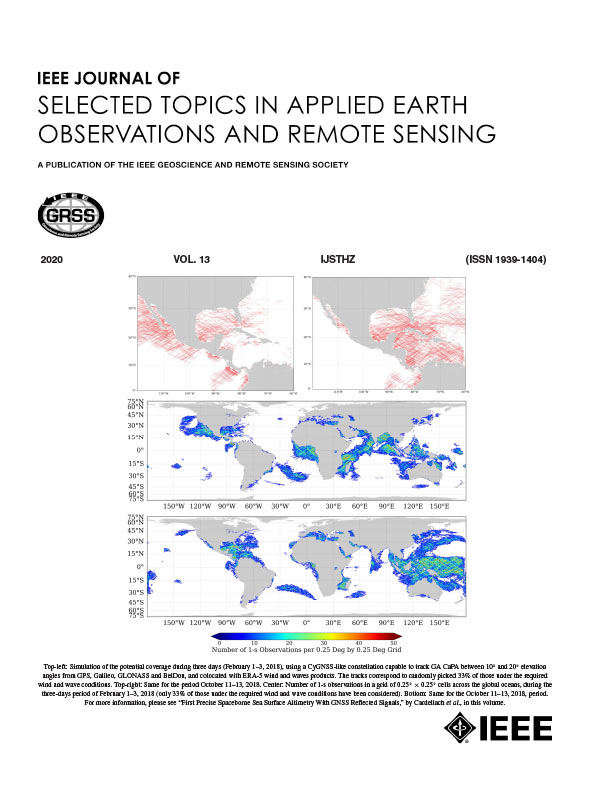CBIPDNet: A Novel Method for InSAR Deformation Interferometric Phase Filtering Using Deep Learning Network
IF 4.7
2区 地球科学
Q1 ENGINEERING, ELECTRICAL & ELECTRONIC
IEEE Journal of Selected Topics in Applied Earth Observations and Remote Sensing
Pub Date : 2024-09-09
DOI:10.1109/JSTARS.2024.3453071
引用次数: 0
Abstract
The denoising of phase is a crucial process that impacts the accuracy of data processing in differential interferometric synthetic aperture radar. Especially in the area of large-gradient deformation, the phase filtering method is very easy to cause phase losses. This has a significant impact on the final deformation acquisition. To address this issue, here, a deep convolutional blind denoising network-based interferometric phase filtering method, named CBIPDNet, is proposed. Different from the previously proposed deep learning phase filtering methods, CBIPDNet does not add noise to the input before filtering, but adds noise to the input during the training process. Furthermore, CBIPDNet uses a CNN structure for adaptive noise estimation and uses a residual module for nonblind filtering. Therefore, CBIPDNet can be considered as an adaptive phase filtering algorithm. More importantly, the added noise is composed of heteroscedastic Gaussian noise + simulated real noise of the imaging process, which is closer to the real interferometric noise phase. Moreover, the denoising effect of targets of different scales through the asymmetric loss function has been significantly improved, which can improve the detail preservation ability of regions with substantial gradient deformations. The experimental results demonstrate that CBIPDNet is capable of enhancing phase quality and increasing phase unwrapping accuracy compared to the current interferometric filtering methods.CBIPDNet:利用深度学习网络进行 InSAR 形变干涉相位滤波的新方法
相位去噪是影响差分干涉合成孔径雷达数据处理精度的关键过程。特别是在大梯度形变领域,相位滤波方法很容易造成相位损失。这对最终的形变采集有很大影响。针对这一问题,本文提出了一种基于深度卷积盲去噪网络的干涉相位滤波方法,命名为 CBIPDNet。与之前提出的深度学习相位滤波方法不同,CBIPDNet 不会在滤波前向输入添加噪声,而是在训练过程中向输入添加噪声。此外,CBIPDNet 使用 CNN 结构进行自适应噪声估计,并使用残差模块进行非盲滤波。因此,CBIPDNet 可被视为一种自适应相位滤波算法。更重要的是,添加的噪声由异性高斯噪声+成像过程中的模拟真实噪声组成,更接近真实的干涉噪声相位。此外,通过非对称损失函数对不同尺度目标的去噪效果也有了明显改善,可以提高梯度变形较大区域的细节保留能力。实验结果表明,与目前的干涉滤波方法相比,CBIPDNet 能够提高相位质量和相位解包精度。
本文章由计算机程序翻译,如有差异,请以英文原文为准。
求助全文
约1分钟内获得全文
求助全文
来源期刊
CiteScore
9.30
自引率
10.90%
发文量
563
审稿时长
4.7 months
期刊介绍:
The IEEE Journal of Selected Topics in Applied Earth Observations and Remote Sensing addresses the growing field of applications in Earth observations and remote sensing, and also provides a venue for the rapidly expanding special issues that are being sponsored by the IEEE Geosciences and Remote Sensing Society. The journal draws upon the experience of the highly successful “IEEE Transactions on Geoscience and Remote Sensing” and provide a complementary medium for the wide range of topics in applied earth observations. The ‘Applications’ areas encompasses the societal benefit areas of the Global Earth Observations Systems of Systems (GEOSS) program. Through deliberations over two years, ministers from 50 countries agreed to identify nine areas where Earth observation could positively impact the quality of life and health of their respective countries. Some of these are areas not traditionally addressed in the IEEE context. These include biodiversity, health and climate. Yet it is the skill sets of IEEE members, in areas such as observations, communications, computers, signal processing, standards and ocean engineering, that form the technical underpinnings of GEOSS. Thus, the Journal attracts a broad range of interests that serves both present members in new ways and expands the IEEE visibility into new areas.

 求助内容:
求助内容: 应助结果提醒方式:
应助结果提醒方式:


